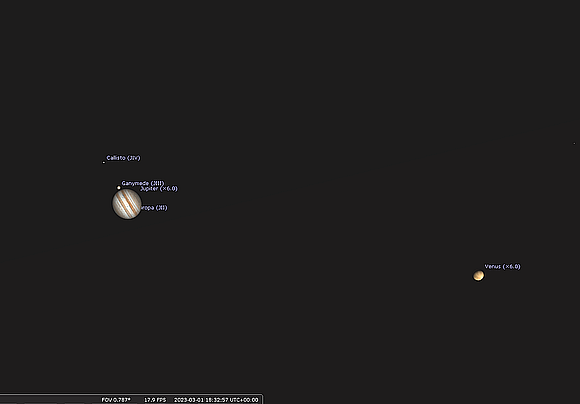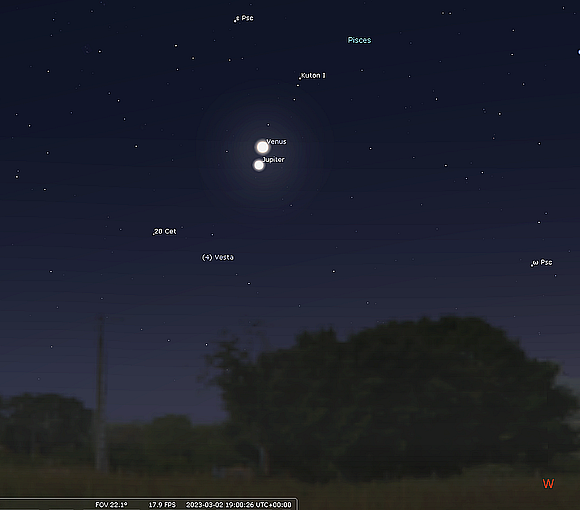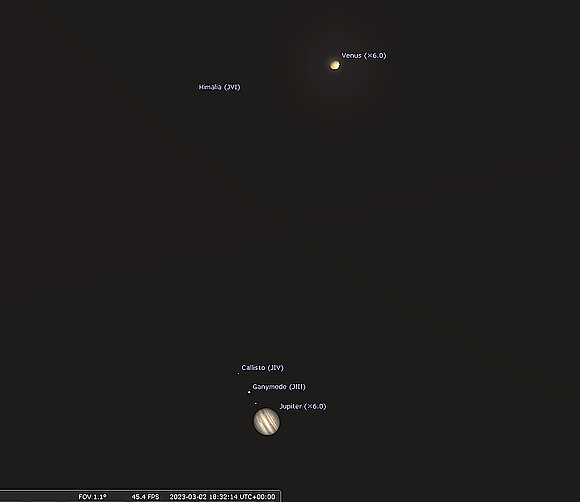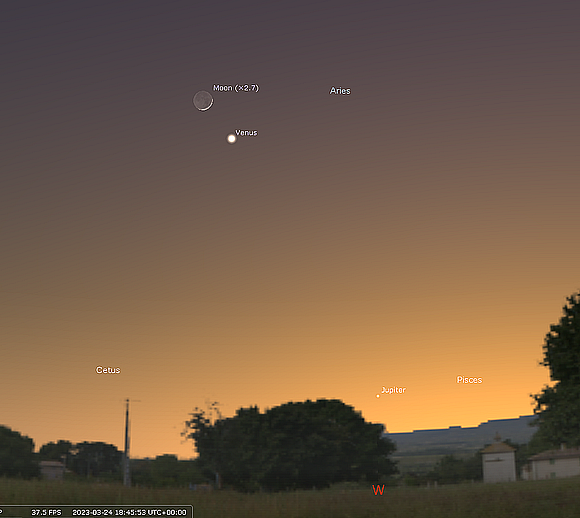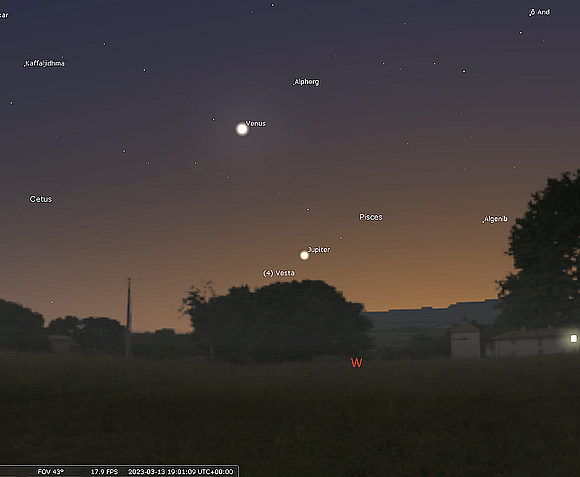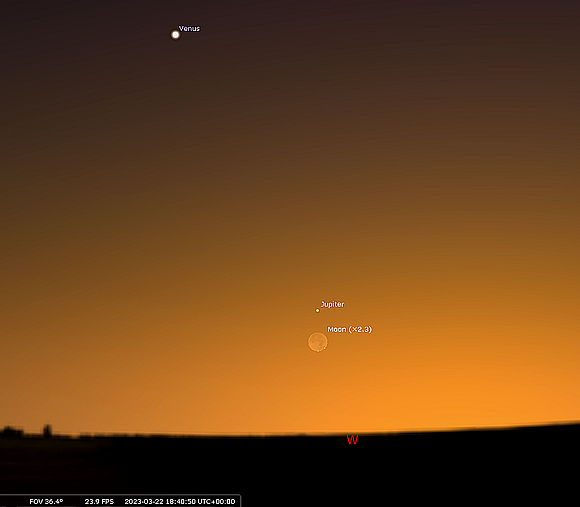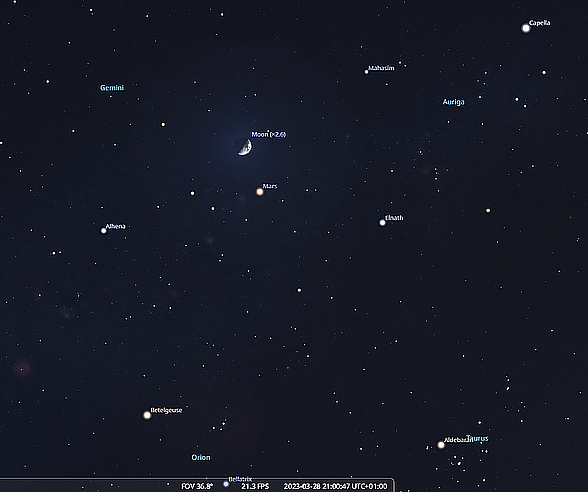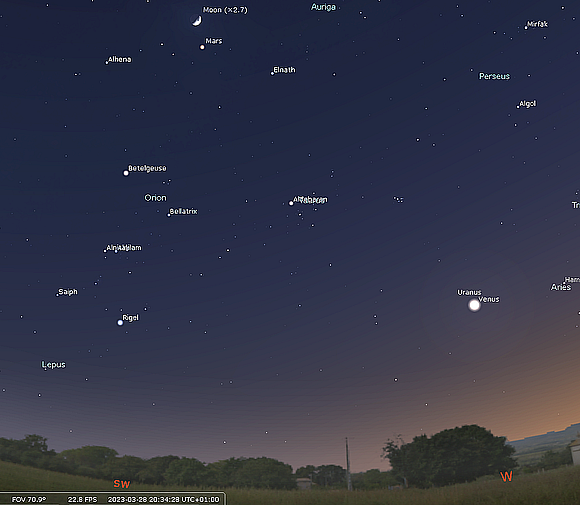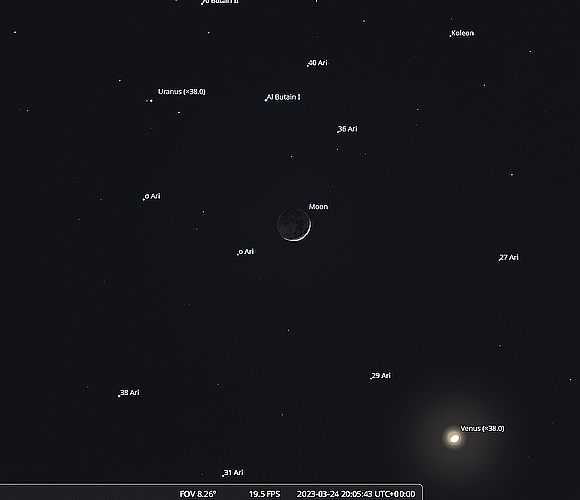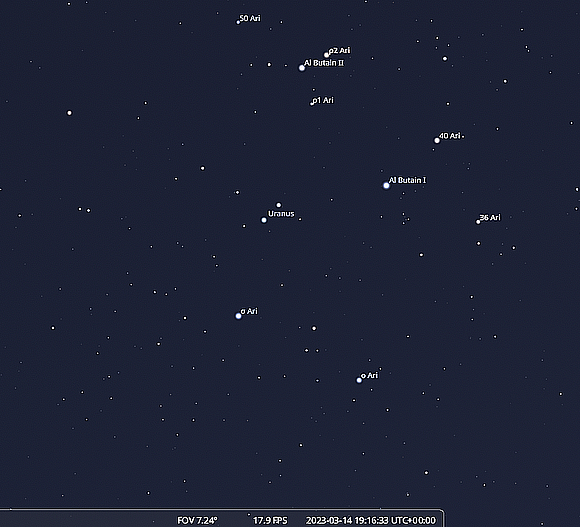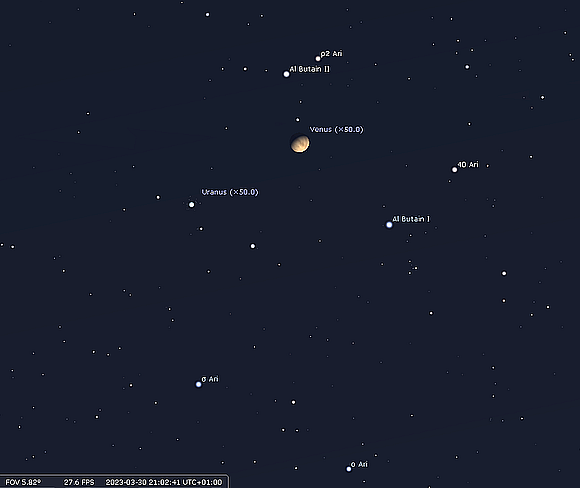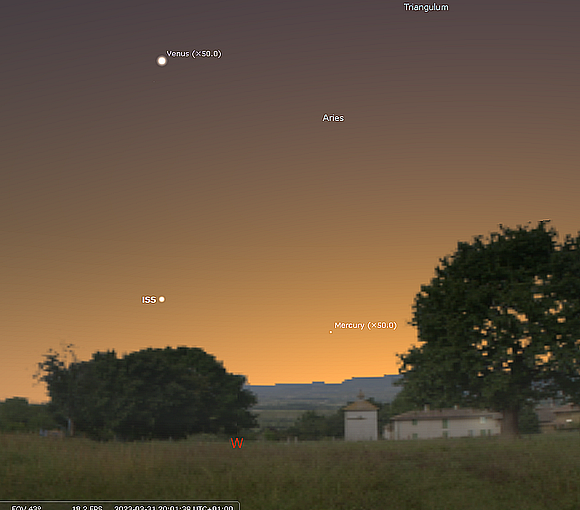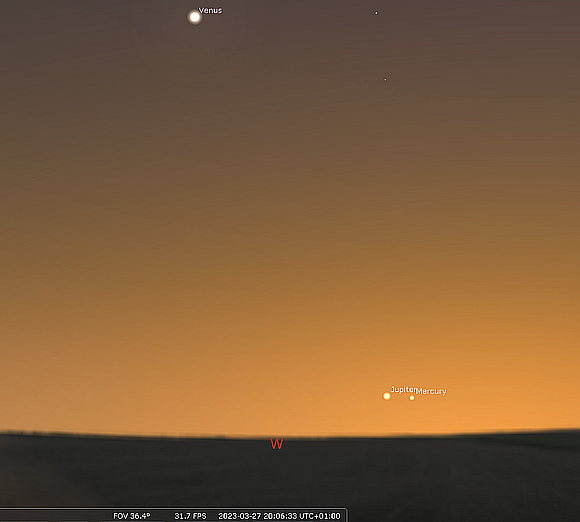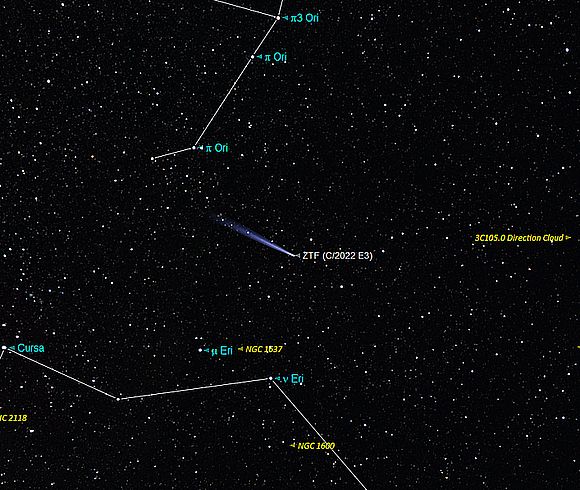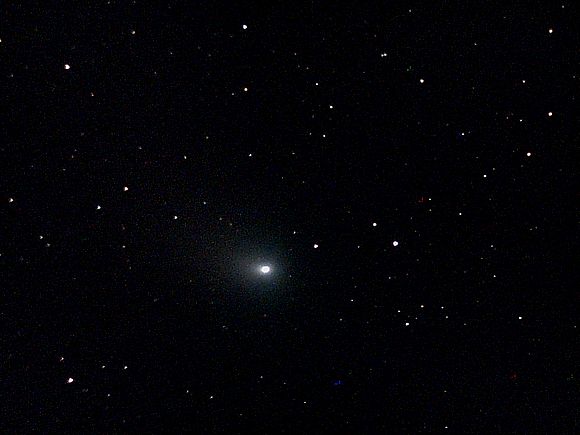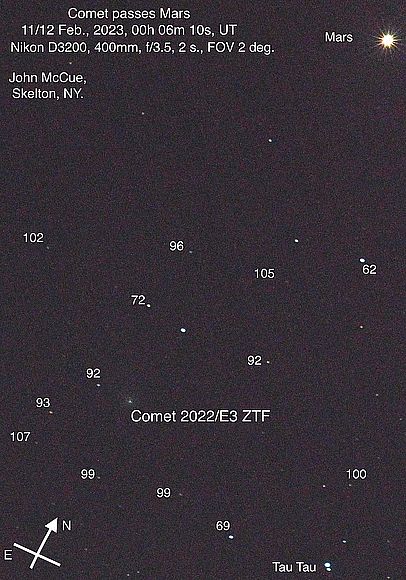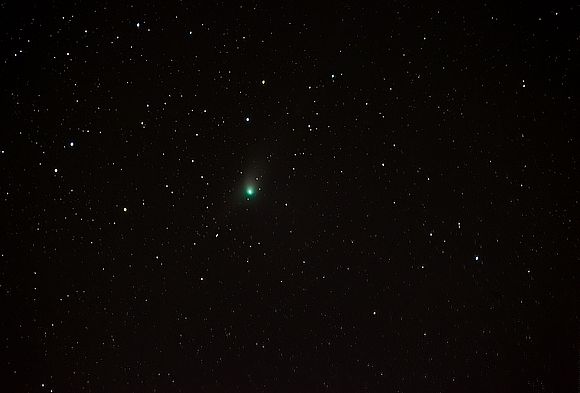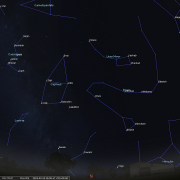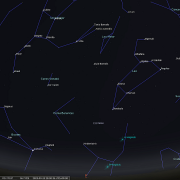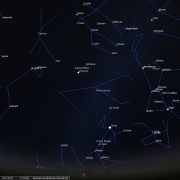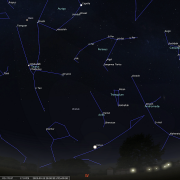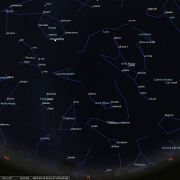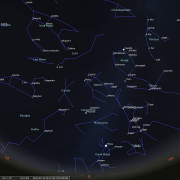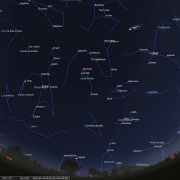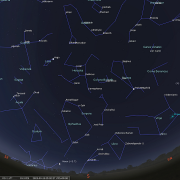In this month's Sky Notes:
- Planetary Skylights.
- March Meteors and Comet 2022 ZTF E3.
- March night Sky.
- The Spring Eqinox.
- March 2023 Sky Charts.
Planetary Skylights - Brief
Jupiter and Venus start the month in close conjunction before they go their separate ways, Jupiter finally dropping out of view by the end of March after one last meeting. Venus dominates the twilight sky and after seeing off Jupiter has an encounter with Uranus. Mars fades in brightness and drops into the WNW. Mercury pops into the west twilight sky meeting Jupiter as it departs. Please remember; UK British Summer Time commences on March 26th, so don't forget to put your clocks forward 1 hour.
 Venus dominates the evening twilight sky over in the SW, gaining further in altitude during March. Shining at mag -4.1, Venus becomes apparent less than 35 minutes after sunset, when it's actually better to observe, being less dazzling. As conspicuous as Venus appears to the naked eye, apart from exhibiting a phase (currently gibbous), surface appearances are less appealing in the eyepiece. The surface is perpetually hidden by a thick duvet of cloud, trapping heat and CO2, turning Venus into world of blistering high temperatures, (480 degrees C) with acidic layers within the atmosphere and surface pressures 90 times that on Earth. Hell, in all but name!
Venus dominates the evening twilight sky over in the SW, gaining further in altitude during March. Shining at mag -4.1, Venus becomes apparent less than 35 minutes after sunset, when it's actually better to observe, being less dazzling. As conspicuous as Venus appears to the naked eye, apart from exhibiting a phase (currently gibbous), surface appearances are less appealing in the eyepiece. The surface is perpetually hidden by a thick duvet of cloud, trapping heat and CO2, turning Venus into world of blistering high temperatures, (480 degrees C) with acidic layers within the atmosphere and surface pressures 90 times that on Earth. Hell, in all but name!
Venus ended February in fine style, joining Jupiter in the sky in a spectacular conjunction. March commences with the two worlds closer still, the pair separated by just 40' arc minutes on March 1st and 2nd, just over the Moon's diameter, presenting a wonderful sight in binoculars, telescope, or just the naked eye. Venus, by far the brighter of the two planets (mag -4.1 as opposed to -2.1), resides to the lower right of Jupiter on March 1st. View through the eyepiece though, Jupiter exhibits the larger disk, despite being 4 times further from Earth than Venus currently is. Venus itself is currently quite far from Earth, around 200 million Km distant. On March 2nd Venus sits directly above Jupiter. Observers using short focal length telescopes of f7 or less should be able to fit both objects in the same field of view at low magnification, making the comparison even more spectacular.
There will be time to view the conjunction (given any clear skies) with the pair over 20 degrees in elevation and not setting until after 20:30hrs GMT. The two worlds will go their separate ways after the 2nd. The crescent Moon will pay Venus a visit on the 24th, before Venus encounters Uranus on March 30th and 31st (see Uranus).
 Jupiter continues its descent into bright twilight glare over in the west, but is just about visible to the naked eye all month. At magnitude -2.1 it is readily visible, indeed would be considered a prominent object, but given that it starts March in spectacular conjunction with Venus - an object twice as bright, it pales in comparison. Thereafter Jupiter drops down to W horizon, becoming mired in twilight, but has one final meeting.
Jupiter continues its descent into bright twilight glare over in the west, but is just about visible to the naked eye all month. At magnitude -2.1 it is readily visible, indeed would be considered a prominent object, but given that it starts March in spectacular conjunction with Venus - an object twice as bright, it pales in comparison. Thereafter Jupiter drops down to W horizon, becoming mired in twilight, but has one final meeting.
A very slim crescent Moon maybe glimpsed below Jupiter on March 22nd and above it the following evening. Before Jupiter finally departs it meets Mercury coming the other way, the two planets appearing side by side on the 27th. Look for them from 19:45hrs BST (no earlier) and you should pick them up in the bright twilight 4 degrees or so above the horizon - due West. Jupiter, the brighter, will be less than one degree left of Mercury, which actually is not that much fainter. Jupiter will have then been in conjunction with both inferior planets, bookending the month of March and a suitable finale to its apparition. It will be early June before Jupiter returns to the dawn sky and almost July before it really becomes noticeable around 03:00hrs BST.
 Mars - the Red Planet is slowly tracking eastwards thru' Taurus passing between the 'horn stars' around mid month, entering into Gemini by the month’s end. Mars is gradually fading in brightness, appearing not dissimilar to nearby Aldebaran (mag 0.87) chief star in Taurus, which is also orange in hue and makes a useful comparison.
Mars - the Red Planet is slowly tracking eastwards thru' Taurus passing between the 'horn stars' around mid month, entering into Gemini by the month’s end. Mars is gradually fading in brightness, appearing not dissimilar to nearby Aldebaran (mag 0.87) chief star in Taurus, which is also orange in hue and makes a useful comparison.
The waxing Moon lies nearby Mars on the 27th and 28th. Through the eyepiece Mars will be disappointing, the disk size having shrunk to less than 8 arc seconds and recognising surface detail will be challenging to say the least. If you like observing orange dots, image quality should be pretty steady with Mars riding high in the sky during early evening at the start of March, but is dropping into the WNW by the month's end.
 Uranus remains a viable observational target for March, but increasingly challenging to track down as April commences. Before then however, Uranus has a date with the 'evening star' - Venus, on March 30th. Located in the lower reaches of Aries, at magnitude +5.85, Uranus is technically visible to the naked eye, though dark, transparent skies are needed to achieve this. Uranus can be spotted as a star-like object through binoculars, but a telescope of 75mm or 3" inch using medium magnification is required to reveal the miniscule ghoulish grey/green disk just 3.6 arc seconds in diameter.
Uranus remains a viable observational target for March, but increasingly challenging to track down as April commences. Before then however, Uranus has a date with the 'evening star' - Venus, on March 30th. Located in the lower reaches of Aries, at magnitude +5.85, Uranus is technically visible to the naked eye, though dark, transparent skies are needed to achieve this. Uranus can be spotted as a star-like object through binoculars, but a telescope of 75mm or 3" inch using medium magnification is required to reveal the miniscule ghoulish grey/green disk just 3.6 arc seconds in diameter.
Perhaps the most difficult aspect of locating Uranus is indentifying the general area of sky in which it currently resides, a "no man's land" devoid of readily apparent naked eye stars in the southeast quadrant of Aries. The nearest 'bright' apparent naked eye stars are sigma Ari and pi Ari at magnitude +5.50 and +5.30 respectively, Uranus sits roughly midway between them. Uranus is slowly moving eastwards against the background stars in the general direction of Taurus. The crescent Moon lies below Uranus on March 24th, however brilliant Venus moves up to join Uranus on March 30th making for an interesting conjunction and great opportunity to spot Uranus as it resides just over a degree lower left of Venus. Use binoculars or a finder scope to frame the two worlds within the same field of view and get your bearings before targeting Uranus. You should spot the grey/green disk with medium powers.
 Mercury returns to the evening sky towards the end of March and may be spotted due West just above the horizon around 20:00hrs BST. This is Mercury's best evening apparition of 2023 and starts off in fine style, being in conjunction with Jupiter on March 27th. It will be tricky to view, but look for the pair just a few degrees above the due West horizon shortly before 20:00hrs BST. At magnitude -1.45 Mercury (on the right) will be slightly fainter than Jupiter, though not by a great amount. You will require a flat, unobstructed W horizon, time will not be on your side either, perhaps 20 minutes before they are lost. Use binoculars to spot them if required, although both should be vsisble to the naked eye.
Mercury returns to the evening sky towards the end of March and may be spotted due West just above the horizon around 20:00hrs BST. This is Mercury's best evening apparition of 2023 and starts off in fine style, being in conjunction with Jupiter on March 27th. It will be tricky to view, but look for the pair just a few degrees above the due West horizon shortly before 20:00hrs BST. At magnitude -1.45 Mercury (on the right) will be slightly fainter than Jupiter, though not by a great amount. You will require a flat, unobstructed W horizon, time will not be on your side either, perhaps 20 minutes before they are lost. Use binoculars to spot them if required, although both should be vsisble to the naked eye.
Mercury just above the W horizon - March 31st @ 20:01hrs BST. The ISS may be visible at 19:47 to the left of Mercury (Click for larger image)
March 27th @ 20:00hrs BST - A challenging conjunction of Mercury and Jupiter.
(Click for larger image)
March Meteor and Comet Activity
March continues where February left off with no recognised meteor showers of note. Even though it is a lean period for shooting stars, those that are spotted are often quite bright and it has been suggested that late January to early March; the 'fireball' season', may be a very old depleted shower of similar nature to the Geminids. Towards the end of March there are signs of activity from the various and complex Virginid radiants, but numbers remain low with 'peak activity' not reached until April. The two main radiants lie near Spica and Kappa Virginis, but typically just a few meteors per hour are recorded by an observer. True Virginids are often slow moving and long in duration, occasionally very bright (similar to Venus say) producing flares along their path. As usual the early morning hours will be most favourable.
Comet 2022 E3 (ZTF)
Comet 2022 E3 is now fading rapidly, just another 'run of the mill' fuzzy blob heading out of the solar system for good? Maybe, if not, certainly for a period our 1000th generation descendants won't even have to worry about! Having caused a bit of a stir in the media, E3 ZTF (the green comet) just about made it to naked eye status, but was best appreciated with binoculars, telescopes and in particular when imaged for any length of time. The comet is now heading southwards passed the pi stars marking the bottom of the 'shield of Orion' and into Eridanus. It has slowed dramatically and diminished in magnitude to +8.75 at the start of the month, becoming a 10th mag object by the end of the month.
Hope you managed to glimpse it, or image the little green blobster. Here are a few images from members to remember E3 ZTF.
Later that same night, returning home to clearer skies,
John McCue imaged the comet below Mars (Click for full image)
For accurate and up-to-date charts for binocular visible comets please visit https://theskylive.com.
The Spring Equinox

The date of the Spring or Vernal Equinox marks the start of astronomical spring in the northern hemisphere falls on March 20th this year. The Vernal Equinox marks a moment, not an entire day, that moment being when the Sun's path on the ecliptic first crosses the celestial equator on its apparent journey northwards into the sky (for the N hemisphere). The orientation of the Earth at the spring or autumnal equinox is such that neither of Earth’s poles is inclined toward the Sun and all locations experience equal hours of daylight and darkness - hence the term equinox, derived from Latin meaning equal night. It is however not true that both day and night are exactly 12 hours long, on this date as daylight is still slightly longer. The actual date of equal daylight and darkness is called the equilux and falls a few days before the spring equinox.
As Spring starts, the length of day increases dramatically in most regions, except for the tropics, where day lengths do not change much during the course of a year. In fact, the increase is greatest in the days surrounding the spring equinox. After that, days still get longer, but at an ever-decreasing rate. On the longest day of the year, the Summer solstice, this day-to-day difference reaches zero. Locations farther from the equator experience larger day-to-day differences. In Whitby the day of the spring equinox is 3 minutes longer than the previous day; whereas in Athens around 2000 kilometers or 1200 miles farther south, the difference is only around 90 seconds. The Vernal Equinox is also known as the 'First point of Aries', as the Sun used to stand before the constellation of the Ram when it first crossed the celestial equator. Although still called the 'first point of Aries', today its location now resides in Pisces, a consequence of the effect known as precession; the Earth's slow wobble.
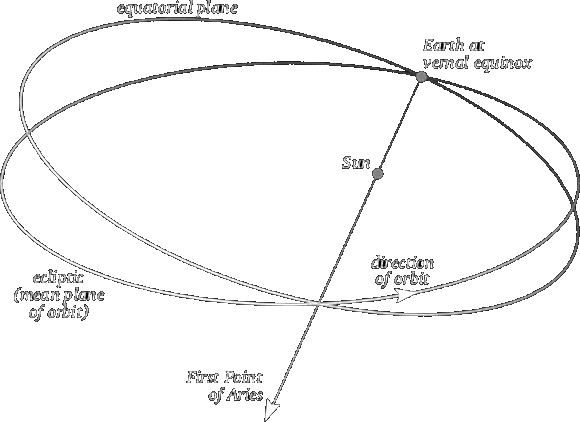
Over thousands of years our ancestors noted that certain star patterns rose just before the Sun at specific times and were considered significant for this very reason. Subsequently they were able to build a picture of the apparent path of the Sun against these constellations. The narrow path upon which occasionally the Sun and Moon would meet giving rise to an eclipse, became known as the Ecliptic. The broader belt along which the 'wandering stars' or planets travelled was known as the Zodiac, so called because all 12 constellations located on it were associated with living creatures. The zodiac constellations extend about 8° north and south of the ecliptic. The signs of the zodiac have origins dating back as far as Babylonian astronomy around 1500 BC, which we know as astrology today. It was also the Babylonians that decided to have 12 zodiac signs, leaving out Ophiuchus.

Zodiac literally means 'circle of little animals'. Libra used to be considered being part of Scopius, the claws to be precise. Ophiuchus, the serpent bearer immediately following Scorpius was instead regarded as a zodiac group. Ever since the stars of Libra were elevated in status, Ophiuchus, being surplus to requirements, was ditched, much to the relief of astrologers. If you find it difficult to remember the order of the zodiac constellations, then the following rhyme may be of use.
The Ram, the Bull, the Heavenly twins
and next the Crab the Lion shines,
The Virgin, and the Scales.
Scorpion, Archer and Sea goat,
The man who pours the water out
and Fish with glittering tails.
March Night Sky
March can be considered as a month of change, both on Earth and relating to the sky. It contains the first days of Spring, both meteorological (March 1st) and Astronomical (March 20th - this year). Furthermore, for UK residents it is the month in which the clocks go forward 1 hour, as we look ahead with optimism to what we jokingly refer to as BST (British Summer Time). Usually this day (whenever it falls during the final week of March), is bleak, cold and wet. It is not uncommon to find snow on the door step; - 'Lions' can roar, 'beasts from the east' can 'shiver our timbers' and wreak havoc with the flora and fauna, falsely enticed out early during the obligatory February heat wave. Occasionally a 'lamb' bleats the arrival, or departure of the month, when evenings really are lighter and thoughts may even turn to Summer on a overly warm weekend. March then can be a 'very odd' month weather-wise.
When it comes to observing the night sky, March is however considered by amateur astronomers as being the crème de la crème of observing windows. Skies are dark for 12 hours or thereabouts, late evenings are perhaps more conducive to spend time under as the threat of wintry conditions recedes. Earth is ideally positioned on its orbit around the Sun as it reaches an equinox station, with the opportunity around this period to view constellations associated with all four seasons in the course of one night. And if the Moon is absent, the celestial marathon runners will be chomping at the eyepiece, but more on this shortly.
The sky itself undergoes a steady progressive shift over the course of March, before what can seem like a jump into spring skies following the arrival of BST time later in the month. If you view early in March, a few Autumnal constellations are still quite well placed for observing. In the WNW you will locate the Great Square of Pegasus with the stars of Andromeda reaching up from the horizon toward the figures of Perseus and Cassiopeia flanking the Zenith - overhead. Circumpolar summer stars are banished to the celestial margins low to the north - as Vega and Deneb in Lyra and Cygnus respectively, flirt with the horizon. The familiar starry Plough asterism in Ursa Major, stands on its tail to the NE, the 'pointer stars' in the bowl of the Plough, Dubhe and Merek, point in the direction of Ursa Minor and Polaris - the Pole star. The Celestial dragon – Draco winds its way between the two bears, the head of the beast marked by an irregular quadrilateral of stars not far from Vega. resides due North. Overhead the distinctive ‘W’ pattern of Queen Cassiopeia first occupies the zenith, followed by Perseus the outline of which resemble a distorted figure Pi symbol) and then the stars of Auriga the charioteer, highlighted by brilliant Capella.
High to the SW the 'V' pattern of the Hyades star cluster, marking the head Taurus, point down to the NW horizon. The marmalade hue of Aldebaran, “the eye of the bull" highlights this cluster, though it is not a proper member, situated at half the distance of true Hyades members. Conspicuous Mars currently resides between the 'horn stars' in Taurus, being of similar hue. Further west of the Hyades, the Pleiades star cluster or Seven Sisters continue to flee from the advances of Orion - the mighty hunter, who marches into the western half of the sky, accompanied by the sparkling tableau of Winter. Orion is Identified by the distinct three belt stars, together with the first magnitude luminaries, Rigel (lower right) and Betelgeuse (top left), both destined to go supernova. Beneath the belt stars resides one of the great showpiece objects in the night sky, the Orion nebula, a region of stellar birth around 1300 light years away and perhaps only 2.4 million years old. This stellar nursary consists of a huge cloud of gas and dust 25 light years in extent, within which star formation is underway. The nebula is seen clearly as a misty smudge through smaller binoculars, but is a breathtaking sight when observed through a telescope. Look for the Trapezium star cluster, the four “bully boys” of this stellar crèche.
Upper left of Orion stand the Twins of Gemini, marked by the two conspicuous stars, Castor and Pollux. Castor, the most northerly of the pair, is slightly fainter than twin brother Pollux which shines with a pale amber lustre. Although Castor appears solitary, in reality it is a multiple system of which the brightest two components may be separated in a modest scope given stable atmospheric conditions. The two hunting dogs of Orion, Canis Major and Canis Minor, dutifully follow their master across the heavens. The belt stars of Orion point down in the general direction of Canis Major and the most prominent of all night stars, sparkling Sirius, visible due south as darkness falls. Above and left, solitary Procyon, in the lesser dog of Canis Minor, is another conspicuous winter jewel. The prominence of both stars is primarily due to proximity; 8.6 and 11 light years respectively. Strangely both stars also have companion white dwarf stars, although they are very difficult to spot even with quite large instruments, being in close proximity to their primary star.
Look for the faint glow of the Winter Milky Way which flows up beside Orion, separating the two dogs on opposing banks. The dogs' quarry is perhaps the celestial hare of Lepus, timidly crouching below the feet of Orion, just above the SSW horizon. Within the faint starry haze left of Orion, a more modern constellation is located, the Unicorn of Monocerus. Its stars are faint and to the naked eye the area looks bland at first glance, but hidden just beyond our gaze reside a multitude of star clusters and nebulae. Below the Unicorn, Puppis, part of the now defunct constellation of Argo Navis straddles the S horizon. It too is rich in galactic clusters and nebulae; including the Messier objects M46, M47 and M93. The longest constellation in the heavens (or at least a section of it) occupies much of the sky lower right of Orion. The river Eridanus, the source of which rises just to the right of Rigel, marked by Cursa or beta Eridii, flows erratically parallel to the southern horizon before plunging through it, journeying far down into the southern hemisphere, ending at a brilliant star called Archenar.
By the time skies become dark following the change to BST, the night sky has a very different look to it. Orion and his entourage are toppling down to west horizon, their places supplanted by an ensemble of Spring constellations. The inconspicuous stars of Cancer scuttling after Gemini mark the border of seasonal change. Cancer may be faint, but contains the open cluster M44 - the Beehive or Preceipe. Leo the Lion follows, the signature group of Spring, identified by the distinctive ‘Sickle’ asterism, at the foot of which shines bright Regulus, which resides almost bang on the ecliptic. Ahead of Regulus and below Procyon, the traceable stars marking the head of Hydra faintly shine. The Water Snakes chief star, Alphard - the "Lonely one" resides a little way below the head, identified by its amber hue and relative brightness. The clock will be ticking toward midnight before the rest of the snake slithers fully into view accompanied by two constellations resting on the coils; Crater the cup and Corvus the crow. . Look for brilliant Arcturus in Bootes to the east, the second brightest star visible from the UK, its orange lustre in vivid contrast to that of sparkling of Sirius to the south. By the end of March, Spica - chief star in Virgo, returns to our skies after being exiled below the horizon for almost 6 months, the sower of crops joining the victims of Hercules, pushing the stars of long nights out of Earth's winters door, as spring proper takes root in the night sky.
As we reach the Spring equinox, astronomers’ thoughts may turn to undertaking an observing marathon, the Messier marathon, identifying as many of the 110 objects listed in the famous 18th century French astronomers catalogue before sunrise the following morning. For example the great nebula in Orion is also known as M42; the Pleiades M45. The letter M stands for Messier, Charles Messier, who was the greatest discovery of comets in the middle of the 18th century. The discovery and subsequent observation of a comet was then considered to be of particular importance, bringing peer recognition, fame and fortune to the discoverer. Throughout years of observations from Paris, Messier encountered many diffuse and fuzzy objects that may have been mistaken as a comet. With assistance from his friend Pierre Mechain he published in three volumes the location, co-ordinates and description of these objects, so that all observers would know of their whereabouts. Over the intervening years the Messier catalogue has been revised several times and in its current form 110 objects are listed. Entries include galaxies, star clusters, nebulae and the catalyst for his work, a supernova remnant, the Crab Nebula in Taurus – M1.
At least a score of messier objects may be seen on any clear night, but because of their distribution in the sky, early spring is especially suited for observing. Galaxies and open star clusters are found in abundance throughout the winter/spring constellations visible during the first part of the night, whilst globular clusters and many nebulae associated with summer skies are visible before dawn. This is how the idea of the Messier Marathon arose, observing as many entries in an all-night endurance race before the Sun rises. Attempted by many amateur astronomers in the northern hemisphere, few complete it and from the UK‘s latitude it's not possible. A humble pair of binoculars are sufficient to show a good number of objects, some, notably M45; the Pleiades, the Orion Nebula (M42), the Andromeda galaxy (M31) and the Beehive cluster in Cancer (M44) are visible to the naked eye alone. All the entries are within the grasp of a decent four and a half inch reflector or refractor telescope, so armed with very modest equipment, a sky chart or APP and a little knowledge of the night sky, even a novice can bag around three dozen objects without burning the midnight oil. The observer will need to hurry though, after the commencement of BST, this special observing window diminishes each night and is over by the second week in April as evenings become lighter after 21:00hrs BST.
March Sky Charts.
Additional Image Credits:
- Planets and Comets where not otherwise mentioned: NASA
- Sky Charts: Stellarium Software and Starry Night Pro Plus 8
- Log in to post comments


